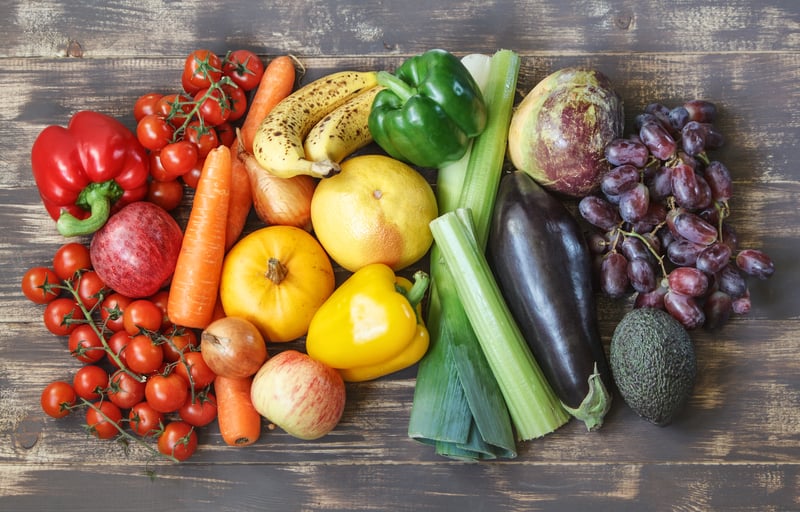How to Keep Fruits & Vegetables Fresher, Longer

One of the most frustrating aspects of cooking whole, nutrient-dense meals at home is ensuring you have fresh, delicious ingredients ready to prepare. Even if you hit the farmers’ market or grocery store every week, by the time you’re preparing meals, some of the fresh vegetables and fruits may no longer look even remotely fresh—especially if they’re stored incorrectly. And right now, especially with the rising costs of groceries, no one wants to let good food go to waste.
So, are there any tricks to helping produce stay fresh for longer? Indeed, there are. How you store your vegetables once they make it home can help ensure they’re still fresh and ready to eat or prepare when you’re ready. Some of these tricks can help them last up to 10 to 15 days or more! Let’s head into the kitchen to get started.
The first steps start as soon as the vegetables enter your home, either from the grocery store, farmers’ market, or online. Set out your vegetables and take stock of what you have. Some vegetables do better if they’re washed immediately. This can include chilis, peppers, and ginger. Others, such as leafy greens, should be stored as they are and washed only right before preparing to eat.
Next, get out your containers, such as clean glass bottles. You can also use reusable plastic, stainless steel, or glass containers, depending on how much you have to store. You may also need paper, plastic, or cloth bags. Remember, with produce, you can easily wash and reuse just about any container to save cash and produce less waste.
Now were ready to look at how to store specific vegetables to help them stay fresher, longer:
How to Keep Fruits & Veggies Fresher, Longer
Apples and Pears
While these fruits look lovely on the countertop, if you won’t be eating them all within a couple of days, they’re better off stored in the crisper drawer in the fridge. That way, you can enjoy a nice, crisp crunch when you bite into them rather than sinking into one that’s soft, or worse, mealy.
If your teeth are sensitive or you just don’t like biting into something super cold, you can leave a couple on the counter to let them return to room temperature before enjoying that crisp texture.
However, apples, especially, are high in ethylene gas, so store them away from other vegetables and fruits. Otherwise, you can increase the speed at which they ripen, leading to early rot.
Asparagus
Cut off at least a bit of the stems and then store upright in a cup or glass of water in the refrigerator, like a bouquet of fresh flowers.
Avocado
Store on the counter until fully ripe—that is, when the avocado is soft and the top little nob (stem) just pops off. Either eat immediately then, or if you aren’t ready, put the avocados in a bowl or directly on a dry shelf and store them in the refrigerator. You can also wipe down the outside of the avocado with citrus to help keep them fresher for longer.
While some folks on social media are recommending submerging avocados in water and placing them in the fridge as the ultimate hack to make them last longer, there are concerns that pathogens like listeria and salmonella are more likely to grow in the water, which could contaminate the fruit by seeping into the stem and then causing illness. Fortunately, you can skip this hack as just storing avocado in the fridge sans water can help extend its taste and texture by up to several days.
If you still don’t have a chance to eat your avocado, you can slice it or mash it up and spoon it into ice trays to add your frozen avocado to smoothies or mix it into hummus. Is that too much work? Then wrap up your avocado (either whole or halved) in plastic wrap or beeswax paper and chuck the entire thing into the freezer for up to six months. When you’re ready to eat it, rinse it in hot water, and allow it to dry and thaw on the counter before cutting into it and using it in recipes. (It probably will never return to the right taste or texture for avocado toast, though, and will be better for recipes or smoothies.)
Berries
Another food that has a notoriously short storage time is berries. One way to help berries like strawberries, blackberries, or blueberries last longer is to give them a vinegar bath with a 1 to 5 (vinegar to water) ratio when they arrive home. Soak for five minutes and then rinse. Gently pat them dry and line the container they come in with a towel before putting the berries back in and placing them in the fridge.
Alternatively, you can transfer the berries to a container lined with a towel to absorb any excess moisture. Then top with a lid (without sealing) and place in the fridge.
The one notable exception is raspberries, which are very fragile. Avoid washing raspberries until it’s time to eat them.
Even with a vinegar rinse, the key to preventing berries from molding is to make sure they have plenty of air circulation and stay dry, and don’t put off eating them.
SPECIAL OFFER: Ageless Turmeric Supports Healthy Inflammation Levels & Detoxification. Now Up to 71% Off.
Bell Peppers
If you purchase these in plastic bags with holes, you can just store them as you received them. If not, you can take a plastic bag, punch in some holes (five or six), and store it in the crisper drawer. You can also wrap them in cling wrap for longer periods of time—over a week. Just avoid washing them before you wrap them as excess water can cause them to rot more quickly.
Carrots
Because they can dry out when stored directly in the crisper, it’s better to keep them in an airtight container or wrap them after removing their leafy tops. Then, they can last up to two weeks.
If you want to have carrots to snack on, cut them up into slices and store them in glass jars with lids. Fill with water to cover the entire vegetable and store where you can see them to grab for a yummy, crisp treat. This works well with celery as well. Just remember to change the water every couple of days to keep them fresh.
Cauliflower or Broccoli
These popular vegetables can be wrapped in plastic and stored in the fridge whole. Alternatively, you can pull apart the individual florets in big chunks with your hands (rather than chopping it). Again, place a towel into a suitably sized container and put in the florets. Add a lid but don’t seal it completely. Then store for up to 10 days.
Cucumber
If you’ll be eating it within a couple of days, cucumber can be stored in a paper or cloth vegetable bag in the vegetable drawer in the fridge. If you need it to last longer, though, you’ll want to again line the bottom of a container with a small towel before putting in the cucumbers, covering with another towel, and storing with a lid in the fridge for up to a week. Alternatively, you can wrap a whole cucumber in a towel and place it in a container or bag.
What if you don’t eat a whole cucumber at once? Go ahead and slice up the rest of the cucumber and store it in a glass jar filled with water, so you can snack on sliced goodies throughout the day or week.
Eggplant
If you purchase these in plastic bags with holes, you can just store them as you received them. If not, you can take a plastic bag, punch in some holes, and store in the crisper drawer. Other foods that can be stored this way are radishes.
Garlic
Remove it from the bag it comes in and store in a wide, flat bowl on the counter. Alternatively, you can peel the garlic and then dry it off with a hand towel before putting it into a glass jar with a lid and storing it in the refrigerator for easy use throughout the week.
Ginger
Clean it well with water and a soft brush. Then set it on a towel and allow it to dry completely. Store the ginger in a container with a towel at the bottom, but first, make sure it is fully dry. Top with a lid, and store in the fridge. As you use the ginger, pat the cut end with a towel to remove any moisture drops before placing it back in the refrigerator.
If you won’t be using it and need to extend the life of your ginger, ginger also stores well in the freezer.
Got fresh turmeric root? Treat it the same as fresh ginger root.
Green Beans
After washing off in some salt water and then rinsing well, store in the fridge in a cloth bag, plastic bag, or container with a lid.
Herbs
These tasty additions to most recipes are notorious for going bad super quickly, especially if they stay in the original packaging. There is, fortunately, an easy solution.
Keep your herbs looking fresh for far longer by storing them as you store flowers. In other words, remove any bags, twist ties, or rubber bands, and place the stems in clear water in a glass or jar. Then store in the fridge. This works well for cilantro, parsley, sage, and other fresh herbs. It looks pretty too!
There’s one notable exception, and that’s basil. Again, it can be placed in a jar or glass of water. However, it prefers room temperature, so just set it on the counter rather than in the fridge. Alternatively, some people just grow a basil plant in a kitchen window and pull off leaves as needed from the growing plant.
Lemons, Limes, and Other Citrus Fruits
Place a towel (paper or cloth) on the bottom of a glass container and gently place it in the fruit. Then store in the fridge. The towel helps reduce the moisture, so the fruit will stay fresh yet juicy for up to two weeks. Alternatively, you can just set them in the crisper drawer with a towel placed on the bottom to help avoid excess moisture.
Mangos
Store in an open bowl on the counter along with other fruits that don’t need refrigeration like bananas or plantains. Once fully ripe, though, you’ll want to move it into the fridge to stop the ripening process and preserve the freshness.
Mushrooms
If you buy them in a cardboard container, just keep them in this container and add a few holes in the plastic wrap to allow them to breathe. Then store them in the fridge. If you buy your mushrooms in bulk, however, you can place them in a cloth bag or in a container wrapped in a towel instead before placing in the fridge. Avoid storing them in just plastic or a sealed container as they then can quickly get soft and slimy.
Nuts and Seeds
To help them last longer without going rancid, store nuts and seeds in a cool, dark place, ideally in the refrigerator. However, if you don’t have room, they can be stored in a cool, dark pantry. They may, however, not last as long.
Onions
Remove any bags and set on the counter or in a pantry, away from potatoes or other produce that can begin to ripen when in close proximity to onions. If stored in a cool, dark place, such as a pantry, basement, or even garage, onions can last up to four weeks. However, you’ll want to store them in an open basket or mesh bag rather than a plastic bag or container as they need proper ventilation.
If you have leftover onion from one recipe, though, and you want to use the rest in a future recipe, slice or dice the onion and store it in a sealed container in the fridge. There, it can last a full week.
BREAKING: Forget Taking Collagen, Try This 21-Second Trick for Healthier Skin & Hair Instead
Potatoes
The first tip is to never store onions and potatoes together as the gas from the onions can cause potatoes to spoil. Remove the bag they come with, and place in an open bowl, mesh produce bag, basket, or even a cardboard box. Then store the potatoes in a cool, dark place, whether in a dark corner of the counter or in the pantry, away from windows or the stove. If you really want potatoes to last, store them in a paper bag or a dark-colored cloth bag to further protect them.
Pumpkins and Squash
Simply wrap the entire vegetable in cling wrap. Or, you can peel and cut the squash into large chunks and store it in a large glass container with an airtight lid.
Scallions
Make another lovely bouquet with your fresh scallions. Place them upright, roots down in clean water and then store them at room temperature on the counter. Then, remember to freshen the water every now and again.
Spinach, Kale, and Other Greens
Remove them from the plastic bags and then remove the leaves from the stems. Next, place a paper towel in the bottom of a container and loosely pack in greens. Top with another paper towel, and cover with a lid before putting it in the fridge.
Alternatively, you can wash full greens, leaving on the stems, and allow to dry. Then place the leaves out flat on a towel, roll up the towel with the greens, and store in the crisper drawer. The goal is to remove the moisture to prevent the greens from getting wilted and gross.
Tomatoes
Store on the kitchen counter in a bowl until they’re ripe. Then move the bowl into the refrigerator. If you bought excess tomatoes, move them into a paper bag and store them in the fridge to last longer, as this method slows down ripening, so they can last up to a week more.
Other Tips for Long-Lasting Vegetables
Before you load up your vegetables in the refrigerator, line your crisper drawer(s) with a clean kitchen towel. This can help absorb excess moisture and spills and help keep the fridge clean and fresh for longer. Then, before you come in from your next shopping trip, you can either wash your towels or replace them with a clean, fresh towel for easy cleanup.
It’s also best to store fruit in one crisper and vegetables in another one or just in containers on the shelves as fruits like apples emit ethylene gas, which can cause other foods to ripen and thus spoil more quickly.
It’s also a good idea to adjust the humidity levels to low for the fruit to help it last longer and prevent gasses from circulating. Vegetables, on the other hand, tend to do better with high humidity settings. So, they can be left out of the crisper or in a separate drawer with the different setting. In general, use low humidity settings for foods that spoil and use high humidity settings for foods that wilt.
Another good rule of thumb is to avoid packing your fridge, especially your produce, too tightly. Allowing air to circulate around the vegetables and fruits can help them last longer. So, whether your produce is going in a drawer or into a container, pack it no more than ¾ full.
As you plan your meals for the week, you can also help prevent waste by using the produce with the shortest lifespan first. That is, shoot for salads with lettuce, spinach, or other tender greens and soft vegetables like cucumbers, small tomatoes, and peppers earlier in the week. Broccoli and cauliflower can last longer, and potatoes and sweet potatoes as well as hearty vegetables like carrot, fennel, and kale will typically last the longest.
Finally, a surprising way to help your vegetables go further is to save your vegetable scraps throughout the week. This includes onion skins, tops of carrots, bottoms of celery, and other odds and ends from veggie prep. Then, once the bag is full (around once a week), you can put it on the stove in a soup bowl, add water, seasoning, and perhaps other vegetables to make your own stock. Boil it down, strain it, squeeze out the liquid to use in any recipes that call for broth. If you don’t have time, you can just toss the scrap bag into the freezer.
Storing vegetables to last longer may take some time and effort, especially after a quick grocery store run on a busy day. Fortunately, you’ll reap big rewards with fresher meals and less lost foods to ultimately save you time and money.






 7 Signs Your Body is Seriously Low on Collagen (not just wrinkles)
7 Signs Your Body is Seriously Low on Collagen (not just wrinkles) Health Expert: "Turmeric Doesn't Work (unless...)"
Health Expert: "Turmeric Doesn't Work (unless...)" 3 Warning Signs Your Probiotic Supplement is a Total Waste
3 Warning Signs Your Probiotic Supplement is a Total Waste

